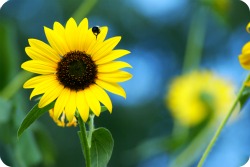The sun is shining, the days are longer and you have waved goodbye to coughs and colds but summer brings its own little irritations. Here are some tips to help.
Sunburn
This is caused by too much exposure to the sun and creates a red and painful skin ailment that can lead to serious skin conditions. Prevention is everything and children should never be exposed to direct sunlight so remember to keep them covered. Loose, light and comfortable clothes are just as cool and offer more cover than strappy summer tops, so are safer. Always put a broad brimmed hat on your child in the sun. Use a high factor sunscreen – at least 30 SPF and reapply it every couple of hours and after swimming. Avoid the sun during the hottest part of the day and keep your child in the shade as much as possible. If your child does get a bit red, give him plenty of water to drink and sponge him down with tepid water. Then cover him with lots of aftersun cream and keep him out of the sun for at least 24 hours.
Stings/Bites
These are usually small, red and itchy bumps that can be painful. Sometimes you can see a hole in the centre of the lump and a sting sticking out of it. Children usually get them if they disturb or are attacked by an insect like a wasp, ant or horsefly. A sting or bite can be quite scary and painful for your child so reassure and comfort him. If the pain or discomfort persists antihistamines and anti-itch ointments can help which are available at pharmacists. If the bite or sting worsens then it is advisable to take your child to the doctor to check if an infection has developed. If your child has difficulty breathing, his tongue swells or you suspect some kind of allergic reaction call emergency medical help immediately.
Nettle Rash
This is a group of itchy, reddish swellings and can often disappear in hours but then reappear somewhere else on the body. It is also known as hives or urticaria. Nettle rash is not caused by stinging nettles although a brush with them can be one of the causes. There are several possible causes although it isn’t always obvious which one it is. It can be a food allergy (for example, to strawberries), pollen, a jellyfish sting, an insect bite or too much sun. It usually passes in a few hours but if you are concerned then seek medical advice. Make sure you check with your doctor before giving your child medication but calamine lotion can be soothing and antihistamines reduce itching and rashes.
Hayfever
This is officially known as allergic rhinitis and is an allergy to airborne pollen from grass, flowers or trees. It causes sneezing, a runny nose and itchy eyes. More common in children over seven years of age but can affect younger children too. There are many medications available but check with your doctor as to what may suit your child best. If your child is really struggling your doctor may prescribe a nasal spray. Generally, the best thing is a long-acting, non-sedating antihistamine syrup and look for suitable medicines containing loratadine or cetirizine.
Prickly Heat
This is also known as heat rash or miliaria. It is a red and itchy rash along with a prickly sensation, hence the name. It occurs during the hotter months and is thought to be caused by blockages in the sweat glands. Young infants and babies are more prone to prickly heat because their sweat glands are not yet fully developed. It can appear anywhere on the body but more commonly on areas that are exposed to the sun or in folds of skin. It is irritating for children but not a serious condition. It usually disappears in a few days. The best thing you can do is keep your child cool if they are suffering from an outbreak of prickly heat. You can place them in a cool bath and pat them dry. Dress them in light, cotton clothes that enable their skin to breathe. Synthetic clothing won’t allow this. If your child is really irritable and unable to sleep then an antihistamine syrup should help.
Eirian Hallinan is Parenting Journals’ newest team member. She believes healing naturally first, especially when it comes to infant colic.
